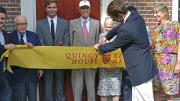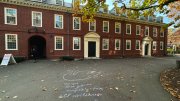On a “momentous and historic day…for all of the Harvard Houses,” Quincy House master Lee Gehrke on September 7 welcomed students, staff and faculty members, top administrators, and donors to the formal dedication of Stone Hall: “Old Quincy” renovated, renamed—for the late Senior Fellow of the Harvard Corporation, Robert G. Stone Jr. ’45, L.H.D. ’03—and symbolizing, its master declared, “the completion of the first step” in a full-scale renewal of the College’s undergraduate living spaces.
As “the key individual who’s in large part responsible for sparking” that undertaking, “central to the future of Harvard College” despite many difficult questions and some skeptics in the early days, Gehrke credited dean of the Faculty of Arts and Sciences (FAS) Michael D. Smith. Smith in turn thanked his host and co-master Deb Gehrke for showing “great bravery in being the first of our House masters to jump in with both feet and embrace House Renewal,” as well as fortitude in dealing with all the “little speed bumps” during the 15-month test renovation project. The outcome, he said,
offers us something truly unique…something akin to time travel.…Through this project, we’re able to experience the future of the House system. When you walk through the hallways, sit in the study niches, chat in the common spaces, talk to our students, you’ll be experiencing the future of the House system, an institution at the core of our student experience.
Through the events of today, I hope that you will come to believe, as I do, that House Renewal is our “once in a generation” opportunity to re-envision that core experience while preserving all that the Houses are and what makes them so special and such a Harvard institution.
House Renewal is predicated on a core belief that at Harvard, learning and discovery happen everywhere across our campus, and that the Houses are the most important place for learning. The Houses are communities where risks are taken, confidence is built, and lasting connections are made with peers, faculty, and tutors. The Houses bring Harvard, a large research university, down to scale.
Smith also acknowledged and thanked the donors who “helped make the vision a reality” (see sidebar), among them Harvard Corporation member Joseph J. O’Donnell and his family. In particular he praised University treasurer James Rothenberg for making “a truly extraordinary and selfless gift” to support House renewal while honoring Bob Stone, who not only loved raising money for Harvard but also, regularly and frequently, breakfasted with groups of undergraduates, many of them recipients of scholarships that he had endowed himself. (Rothenberg has said that he and his wife, Anne, were “grateful for this opportunity to honor Bob Stone, a truly extraordinary Harvard citizen. Bob’s many contributions to the University are legendary, and with the unveiling of Stone Hall, it is fitting that his name will now grace one of Harvard’s most enduring traditions,” the residential House system that is “the heart of the College experience. We’re pleased to be a part of an effort that effectively will transform a liberal arts education in the twenty-first century—undergraduates will experience Harvard as they never have before.”)
President Drew Faust (unable, like Rothenberg, to attend the ceremony), conveyed greetings in a letter read by Geyser University Professor emeritus and former FAS dean Henry Rosovsky. Recalling a “tall man with a wide reach in every sense of the word,” a passionate sailor and philanthropist who “captained an energetic crew of alumni volunteers, serving as a mentor for a generation of leaders working on behalf of Harvard,” she called it fitting that the dedication ceremony fell on Field Day, “when the entire Quincy House family comes together in a celebration of camaraderie, House spirit, and Penguin pride.…The newly transformed Stone Hall unites innovation with tradition, creating a Harvard that looks to the future while honoring the past.” (Rothenberg, she suggested, followed Stone’s lead: “With his remarkable gift to place Bob’s name on Stone Hall, he has set a new standard for House renewal philanthropy.”)
Rosovsky, recalling an old friend who, “when he slapped you on the back, [sent you] from the end of one room to the other,” added, “Bob understood and upheld Harvard values. He knew that those values were…changing all the time.…When he died in 2006, he probably understood that Harvard was in many ways a much better place than when he graduated…and he could be justifiably proud of that achievement.”
Both Smith and Lee Gehrke defined the biggest challenge during the renovation as creating a Quincy House community that included both the resident undergraduates and the temporarily displaced students living in swing space, and that gave them all a sense of being at home. With Stone Hall now complete, Smith declared proudly that it passes “the ‘slipper test,’ allowing residents to visit friends and tutors without traveling outdoors.” His cozy image matched the enthusiasm of the undergraduates for whom the building is a home away from home. Among the high points, as relayed by Quincy House Committee co-chairs Ginny Fahs ’14 and James Wood ’14: the new horizontal, rather than vertical, entryways, mean it will be even easier for new sophomores to make friends; the elevators make fourth-floor living“so much easier”; the beautiful courtyard, “missed so much last year,” is finally back in action and “today we have Field Day back in our own House.”
Bob Stone—who (his son Gregg ’75, J.D. ’79, told the audience) loved a good party, never forgot the importance of funded depreciation, and for whom Harvard College was “the great cause of his life”—would likely have been delighted. President Faust put it well: “I can think of no better way to honor his memory than for future generations of students to call Stone Hall their home.”
Updated September 10, 2013, at 9:30 a.m. with new material from James Rothenberg.










